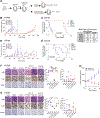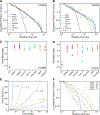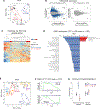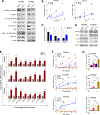Colorectal Cancer Cells Enter a Diapause-like DTP State to Survive Chemotherapy
- PMID: 33417860
- PMCID: PMC8437243
- DOI: 10.1016/j.cell.2020.11.018
Colorectal Cancer Cells Enter a Diapause-like DTP State to Survive Chemotherapy
Abstract
Cancer cells enter a reversible drug-tolerant persister (DTP) state to evade death from chemotherapy and targeted agents. It is increasingly appreciated that DTPs are important drivers of therapy failure and tumor relapse. We combined cellular barcoding and mathematical modeling in patient-derived colorectal cancer models to identify and characterize DTPs in response to chemotherapy. Barcode analysis revealed no loss of clonal complexity of tumors that entered the DTP state and recurred following treatment cessation. Our data fit a mathematical model where all cancer cells, and not a small subpopulation, possess an equipotent capacity to become DTPs. Mechanistically, we determined that DTPs display remarkable transcriptional and functional similarities to diapause, a reversible state of suspended embryonic development triggered by unfavorable environmental conditions. Our study provides insight into how cancer cells use a developmentally conserved mechanism to drive the DTP state, pointing to novel therapeutic opportunities to target DTPs.
Keywords: MRD; autophagy; barcode; chemotherapy; colorectal cancer; diapause; drug tolerant persisters; equipotent; mTOR; slow-cycling.
Copyright © 2020 Elsevier Inc. All rights reserved.
Conflict of interest statement
Declaration of Interests J.M. is a shareholder in Northern Biologics and Pionyr Immunotherapeutics and an advisor for Century Therapeutics and Aelian Biotechnology.
Figures








Comment in
-
A Malignant Case of Arrested Development: Cancer Cell Dormancy Mimics Embryonic Diapause.Cancer Cell. 2021 Feb 8;39(2):142-144. doi: 10.1016/j.ccell.2021.01.013. Cancer Cell. 2021. PMID: 33561394
References
-
- Balaban NQ, Gerdes K, Lewis K, and McKinney JD (2013). A problem of persistence: still more questions than answers? Nat Rev Microbiol 11, 587–591. - PubMed
-
- Balaban NQ, Merrin J, Chait R, Kowalik L, and Leibler S (2004). Bacterial persistence as a phenotypic switch. Science 305, 1622–1625. - PubMed
-
- Benjamin D, Sato T, Cibulskis K, Getz G, Stewart C, and Lichtenstein L (2019). Calling Somatic SNVs and Indels with Mutect2. bioRxiv, 861054. 10.1101/861054. - DOI
-
- Bhang HE, Ruddy DA, Krishnamurthy Radhakrishna V, Caushi JX, Zhao R, Hims MM, Singh AP, Kao I, Rakiec D, Shaw P, et al. (2015). Studying clonal dynamics in response to cancer therapy using high-complexity barcoding. Nat Med 21, 440–448. - PubMed
Publication types
MeSH terms
Substances
Grants and funding
LinkOut - more resources
Full Text Sources
Other Literature Sources
Medical
Molecular Biology Databases
Research Materials
Miscellaneous

